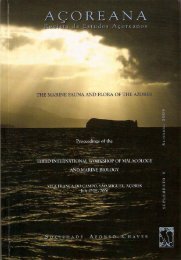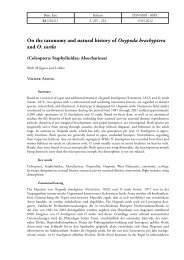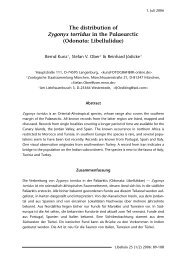(eds.) (2005). - Portal da Biodiversidade dos Açores - Universidade ...
(eds.) (2005). - Portal da Biodiversidade dos Açores - Universidade ...
(eds.) (2005). - Portal da Biodiversidade dos Açores - Universidade ...
Create successful ePaper yourself
Turn your PDF publications into a flip-book with our unique Google optimized e-Paper software.
plantas vasculares endémicas terão já sido descobertas<br />
(Fig. 6b) e que poucas espécies de briófitos<br />
endémicos virão a ser descobertas.<br />
A proporção de espécies endémicas de plantas<br />
vasculares (VP) em relação às espécies endémicas<br />
de artrópodes (A) nos <strong>Açores</strong> é semelhante à encontra<strong>da</strong><br />
para o planeta (Quadro 9), mas é ligeiramente<br />
superior em relação à encontra<strong>da</strong> para as<br />
Canárias. Como se espera que a taxa de descrição<br />
de novas espécies de artrópodes se mantenha constante<br />
nas próximas déca<strong>da</strong>s (ver Fig. 12c), atingindo<br />
facilmente as 400 espécies ou mais (ver Fig.<br />
13d), também se espera que a razão VP/A diminua<br />
para valores similares aos <strong>da</strong>s ilhas Canárias.<br />
Pode-se questionar e debater se as estimativas<br />
<strong>da</strong> riqueza de artrópodes e moluscos que se apresentam<br />
serão as que se esperariam para um arquipélago<br />
como o <strong>dos</strong> <strong>Açores</strong>, isolado no meio do<br />
oceano. A julgar pelo grande número de novas espécies<br />
que foram descobertas quando se investigaram<br />
novos habitats (e.g. cavi<strong>da</strong>des vulcânicas e<br />
copas <strong>da</strong>s árvores para os artrópodes; ver Borges &<br />
Oromí <strong>2005</strong>; Borges & Wunderlich em prep.), ou<br />
quando se implementaram novos protocolos de<br />
amostragem (Borges et al. <strong>2005</strong>b; Ribeiro et al.<br />
<strong>2005</strong>), concluímos que muitas <strong>da</strong>s espécies são<br />
descobertas apenas porque se desenvolvem esforços<br />
para amostrar partes <strong>da</strong> paisagem ou locais que não<br />
tinham sido anteriormente estu<strong>da</strong><strong>dos</strong> de forma adequa<strong>da</strong>.<br />
No caso <strong>da</strong>s plantas vasculares e briófitos, a<br />
revisão taxonómica de alguns géneros poderá gerar<br />
novas espécies endémicas. No entanto, para alguns<br />
grupos mal estu<strong>da</strong><strong>dos</strong> de artrópodes, como as vespas<br />
parasitóides (Hymenoptera), espera-se que<br />
muitas mais espécies sejam descritas no futuro<br />
Quadro 9. Riqueza de plantas vasculares (VC), artrópodes (A) e relação VP/A para o planeta, Canárias e <strong>Açores</strong>. Os valores<br />
para os <strong>Açores</strong> e Canárias referem-se às espécies endémicas.<br />
Table 9. Richness of vascular plants (VP), arthropods (A) and ratio VP/A for the world, Canary Islands and Azores. The<br />
numbers for the Azores and the Canaries relate to endemics. (1) Heywood & Watson (1995); (2) Izquierdo et al. (2001).<br />
Taxa<br />
Planeta<br />
(World) (1)<br />
52<br />
(Fig. 13b) and few endemic bryophytes still will<br />
be discovered (Fig. 13a).<br />
The proportion of endemic vascular plants<br />
(VP) to endemic arthropods (A) in the Azores is<br />
similar to that of global ratio (Table 9), but it is<br />
higher than in the Canary Islands. It is expected<br />
that the rate of description of new species of<br />
arthropods will remain constant in the next<br />
decades (see Fig. 12c) and will easily reach 400<br />
species or more (see Fig. 13d), which will<br />
decrease the VP/A ratio to one similar to that of<br />
the Canary Islands.<br />
Just how representative the estimates presented<br />
here as the real number of arthropods and<br />
molluscs are of what one would expect for an<br />
isolated island archipelago like the Azores could<br />
be the subject for much debate. Judging by the<br />
large number of new species that were discovered<br />
when new habitats were investigated (e.g. caves<br />
and tree canopies for arthropods; see Borges &<br />
Oromí <strong>2005</strong>; Borges & Wunderlich in prep.), or<br />
when new sampling protocols were implemented<br />
(Borges et al. <strong>2005</strong>b; Ribeiro et al. <strong>2005</strong>), we<br />
conclude that many species might appear as a<br />
result of more diligent efforts to implement new<br />
sampling methods in previously ignored parts of<br />
the landscape or at sites that were not sufficiently<br />
studied previously.<br />
In the case of vascular plants and bryophytes<br />
the taxonomic revision of some genera may generate<br />
new endemic species. However, for some<br />
poorly studied arthropod groups, like the parasitic<br />
wasps (Hymenoptera) we expect that many more<br />
species will be described in the near future as a<br />
consequence of the recent interest in the group<br />
Canárias<br />
(Canaries) (2)<br />
<strong>Açores</strong> (Azores)<br />
Plantas vasculares (vascular plants) (VP) 270,000 511 68<br />
Artrópodes (arthropods) (A) 1,030,000 2,704 267<br />
VP /A 0.26 0.19 0.25

















